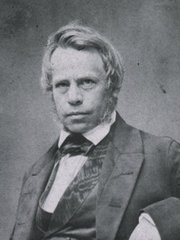This article is part of the series "A Moment in History" where we honor those who have contributed to the growth of medical knowledge in the areas of anatomy, medicine, surgery, and medical research.

Friedrich Gustav Jakob Henle
Friedrich Gustav Jakob Henle (1809 -1885) German physician, anatomist, histologist, and physiologist. Born in the city F?rth, Henle entered the University of Bonn and studied anatomy with Johannes Muller (1801 – 1859), a professor of anatomy and histology. Henle dedicated his efforts to scientific research, and became the managing editor of the journal “Archives of Anatomy, Physiology, and Scientific Medicine” founded by Muller.
Henle’s career in Berlin suffered after he was arrested for 40 days in jail, because of his past membership in a radical liberal and nationalistic student fraternity, the Burschenschaften. He transferred from Berlin to Zürich where he founded the School of Rational Medicine.
Among his publications, the “Allgemeine Anatomie “(1841) is considered the first treatise on microscopic histology. Also, his book “Handbuch der systematischen Anatomie des Menschen” (Handbook of Human Systematic Anatomy) is a great anatomy book with good illustrations.
Henle moved from Zürich to Heidelberg, and from there to Gôttingen, where he accepted the position of Professor of Anatomy. He stayed at Gôttingen until his death in 1885.
Henle’s many remembered contributions are mostly in the area of histology. His name is found in many eponyms. The eponym most associated with his name is “Henle’s loop”, part of the tubular component of a nephron.
- Crypts of Henle: Microscopic pockets located in the conjunctiva of the eye
- Henle's fissure: Fibrous tissue between the cardiac muscle fibers.
- Henle's ampulla: Ampulla of the uterine (Fallopian) tube
- Henle's layer: Outer layer of cells of root sheath of a hair follicle.
- Henle's ligament (tendon): Tendon of the transversus abdominis muscle.
- Henle's membrane: The layer forming the inner boundary of the choroid of the eye
Sources:
1. "The Origin of Medical Terms" Skinner, HA 1970 Hafner Publishing Co.
2. “The Man Behind the Eponym Jacob Henle: Henle’s Layer of the Internal Root Sheath” Steffen C. Am J Dermatopath (2001) 23(6): 549–551
3. “The life of Jacob Henle” Robinson A Medical Life Co. 1921.
Original image in the public domain. Courtesy of Wikipedia.



